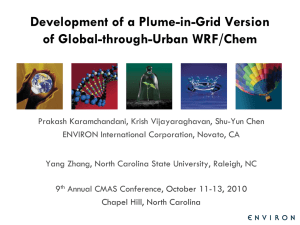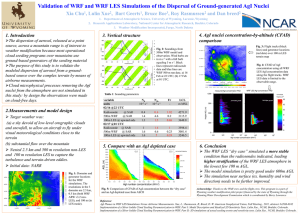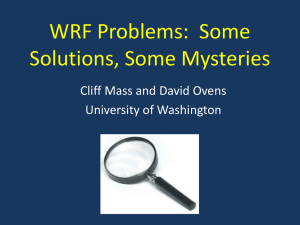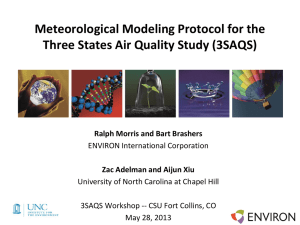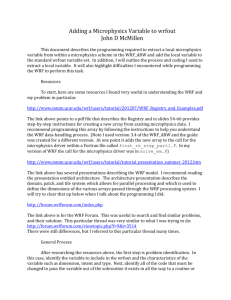WRF Modifications
advertisement
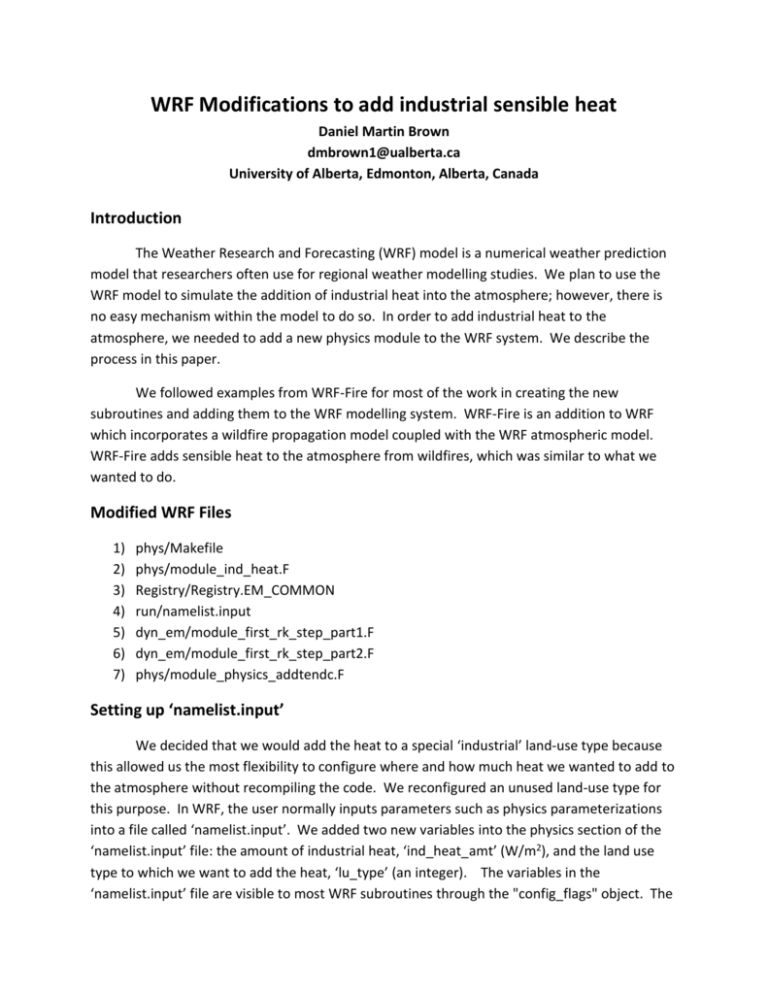
WRF Modifications to add industrial sensible heat Daniel Martin Brown dmbrown1@ualberta.ca University of Alberta, Edmonton, Alberta, Canada Introduction The Weather Research and Forecasting (WRF) model is a numerical weather prediction model that researchers often use for regional weather modelling studies. We plan to use the WRF model to simulate the addition of industrial heat into the atmosphere; however, there is no easy mechanism within the model to do so. In order to add industrial heat to the atmosphere, we needed to add a new physics module to the WRF system. We describe the process in this paper. We followed examples from WRF-Fire for most of the work in creating the new subroutines and adding them to the WRF modelling system. WRF-Fire is an addition to WRF which incorporates a wildfire propagation model coupled with the WRF atmospheric model. WRF-Fire adds sensible heat to the atmosphere from wildfires, which was similar to what we wanted to do. Modified WRF Files 1) 2) 3) 4) 5) 6) 7) phys/Makefile phys/module_ind_heat.F Registry/Registry.EM_COMMON run/namelist.input dyn_em/module_first_rk_step_part1.F dyn_em/module_first_rk_step_part2.F phys/module_physics_addtendc.F Setting up ‘namelist.input’ We decided that we would add the heat to a special ‘industrial’ land-use type because this allowed us the most flexibility to configure where and how much heat we wanted to add to the atmosphere without recompiling the code. We reconfigured an unused land-use type for this purpose. In WRF, the user normally inputs parameters such as physics parameterizations into a file called ‘namelist.input’. We added two new variables into the physics section of the ‘namelist.input’ file: the amount of industrial heat, ‘ind_heat_amt’ (W/m2), and the land use type to which we want to add the heat, ‘lu_type’ (an integer). The variables in the ‘namelist.input’ file are visible to most WRF subroutines through the "config_flags" object. The individual ‘namelist.input’ variables are accessed in the WRF subroutines by using ‘config_flags%variable_name’, where ‘variable_name’ is the name of the variable in the ‘namelist.input’ file. In order to add the two new variables to the ‘namelist.input’ file we had to add a record for each variable to the ‘Registry/Registry.EM_COMMON’ file. These records are added to the ‘namelist’ physics section of the file as "rconfig" variables. The main ‘grid’ object The model communicates its current ‘state’ using the ‘grid’ object. The current state of the model includes arrays of data such as the pressure, temperature, density, land use type, radiation, etc. These variables are accessed by using ‘grid%variable_name’, where ‘variable_name’ is the name of the variable to be accessed. The list of possible variables is stored in the WRF registry. WRF needs to be able to access our industrial heat variable through all modules and subroutines, so we must added it as a global variable to WRF as a part of the ‘grid’ object. We created a new global state variable called, ‘rthindten’, by adding a record describing the new state variable with ikj dimensions to the "Registry/Registry.EM_COMMON" file. This new variable is now accessible in many of the WRF subroutines. WRF temperature tendency variables are 3 dimensional variables. We are adding our heat only to the first level of the atmosphere, so the industrial temperature tendency is zero everywhere else. It is also zero wherever the WRF land use category does not equal our prechosen land use category from the namelist file. In the lowest level over our chosen land use type, the tendency is calculated as described in the next section. The model grid is divided into a number of tiles intended to facilitate tasks for multiple processors. In this case, we just loop through all the tiles at once. New industrial heat physics module In order to add industrial heat to the atmosphere, we wrote a new physics module: ‘module_ind_heat’, and added it to the ‘phys’ folder. The module contains one subroutine: ‘ind_heat’. It takes as input the main grid for the model (grid), the namelist flags (config_flags), the indices of the model area, the air density, the ground elevation, and the thickness of the layer. It outputs the industrial heat tendency variable (rthindten). Once all the variables and dimensions are specified, the following is done by the subroutine: 1. The ‘namelist.input’ file specifies the industrial heat amount (W/m2) and flags the land use index to which we will add the industrial heat. We pull both of these values out from the ‘config_flags’ object. 2. The program loops through all the tiles on the grid and does the following to each tile: 2.1. The starting and ending indices for all three dimensions of each tile are pulled from the main grid. 2.2. We loop through all dimensions of ‘rthindten’ and set it to zero everywhere. Fortran seems fill the array with random numbers if it is not set to zero first. 2.3. We loop through all dimensions of ‘rthindten’ and do the following: 2.3.1. We pull the land use type for the current grid cell from the main "grid" object, and convert it from a real number to an integer to prevent any rounding errors. 2.3.2. We test whether it is equal to the land use index from the namelist file. 2.3.3. If it is the correct type, then we calculate the heating temperature tendency using the following equations: We start with the heat capacity equation: Q mc p T (1) Where ΔQ is the change in internal energy of the system, m is the mass of air, cp is the heat capacity of air at constant pressure, and ΔT is the temperature change associated with the change in internal energy. We can find ΔT by rearranging Equation (1) and making the following substitutions: Q T (2) mc p Using the relation m V , where ρ is the air density and V is the volume of air, we find: Q T (3) Vc p We use V Ah to rewrite the volume as the surface area (A) multiplied by the height (h), giving us the next iteration of the equation: Q T (4) Ahc p We note that ΔQ divided by the surface area gives us the heat flux (Flx), and arrive at the final equation: Flx T (5) hc p The heat flux (Flx) is specified in the ‘namelist.input’ file. The air density (ρ), height (h), and the specific heat capacity (cp) are all pulled out of the main "grid" object. These allow us to calculate the temperature tendency due to the industrial heat input specified in the ‘namelist.input’ file. This is the temperature tendency that we need to add to the main temperature tendency equation in the next section. Because the WRF equations are in flux form, the tendency equations are coupled with the total air column mass (‘mut’ in the WRF registry). We also need to multiply our tendency by the total air column mass to have it in the same form as the other tendency terms. Our new equation then becomes: T M ut Flx hc p (6) This is the final step in preparing the equation for input into the modelling code. Our equation in the code becomes: rthindten(i,kk,j) = mu*cp_i*rho_i*heat/dz8w(i,kk,j), where kk = 1 (the lowest level of the atmosphere), i and j are the x and y indices, cp_i is the inverse of the specific heat capacity (1/cp), rho_i is the inverse of the density (1/ρ), heat is the industrial heat flux (Flx), and dz8w is the thickness of the current level of the atmosphere. After we calculate this, we check if it is equal to itself. This is a Fortran trick to make sure that the number is defined. If the number is not equal to itself, it is not defined and we set it to zero. In theory this should never happen. In order for the WRF system to compile the new code, a line must be added to the ‘phys/Makefile’ file to include the new ‘module_ind_heat.o’ module in the list of modules to compile. Communication between the new industrial heat module and WRF WRF needs to be able to call the new industrial heat module and needs to be able to use the output from the new module. We added a small amount of code into the file ‘dyn_em/module_first_rk_step_part1.F’ to call the new industrial heat subroutine. The new subroutine returns the industrial heat tendency which is added into the main ‘grid’ object. Once the new module and subroutines are executed, a subroutine in the file ‘dyn_em/module_first_rk_step_part2.F’ calls another subroutine, ‘update_phy_ten’ which sums all the tendencies. We just have to add our new heating variable to the call to the ‘update_phy_ten’ subroutine. . Many changes need to be made to the file ‘phys/module_physics_addtendc.F’. We must accept the new variable send in from ‘dyn_em/module_first_rk_step_part2.F’ in the subroutine header. At the end of the ‘update_phy_ten’ subroutine we call a new subroutine called ‘phy_ind_ten’. This subroutine takes our rthindten variable and sends it into the ‘add_a2a’ subroutine, which is the final step. The ‘add_a2a’ subroutine adds our industrial heating tendency to the total model temperature tendency. Summary 1. 2. 3. 4. 5. 6. 7. Modify ‘Registry/Registry.EM_COMMON’ to include the new ‘state’ and ‘namelist.input’ variables. Write code for addition of heat as a ‘.F’ Fortran file in the ‘phys’ directory. Add the name of the new module ‘.o’ file to ‘phys/Makefile’ in the list of modules. Add the new ‘rthindten’ variable to the ‘Registry/Registry.EM_COMMON’ file. Add code to call the new module in "dyn_em/module_first_rk_step_part1.F". Add code to add the new "rthindten" variable to the "update_phy_ten" subroutine call. Modify the "phys/module_physics_addtendc.F" code to accept the rthindten variable and add it to the temperature tendency.
